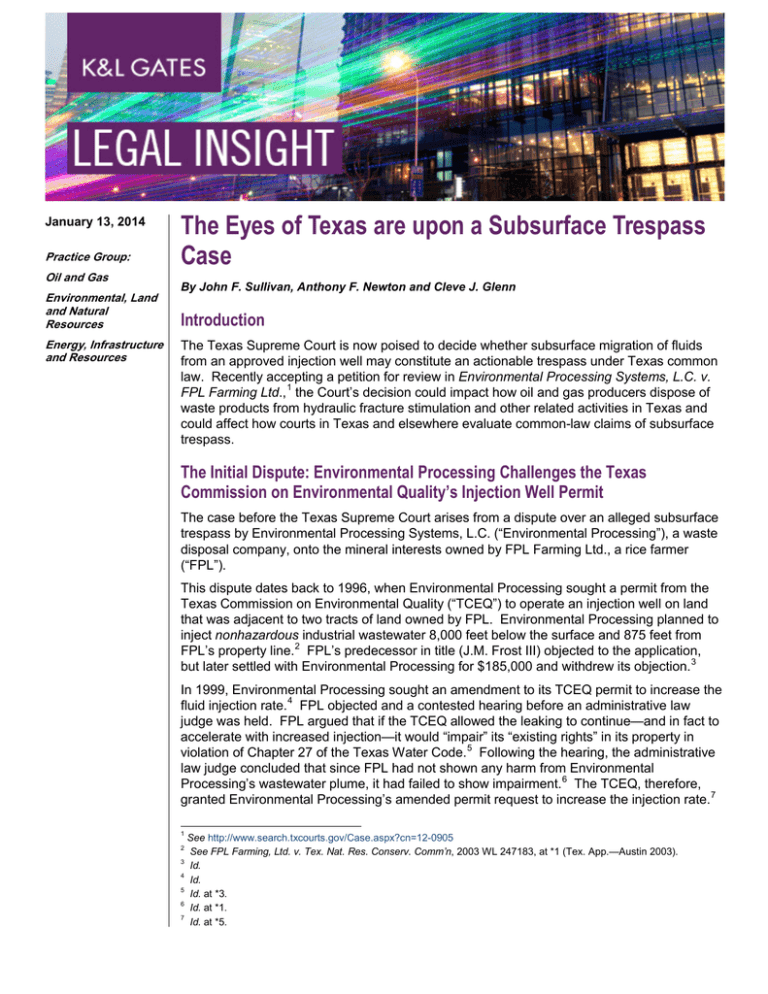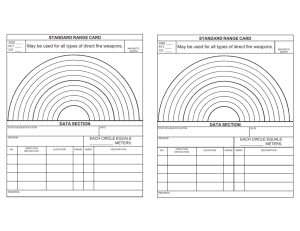
January 13, 2014
Practice Group:
Oil and Gas
Environmental, Land
and Natural
Resources
Energy, Infrastructure
and Resources
The Eyes of Texas are upon a Subsurface Trespass
Case
By John F. Sullivan, Anthony F. Newton and Cleve J. Glenn
Introduction
The Texas Supreme Court is now poised to decide whether subsurface migration of fluids
from an approved injection well may constitute an actionable trespass under Texas common
law. Recently accepting a petition for review in Environmental Processing Systems, L.C. v.
FPL Farming Ltd., 1 the Court’s decision could impact how oil and gas producers dispose of
waste products from hydraulic fracture stimulation and other related activities in Texas and
could affect how courts in Texas and elsewhere evaluate common-law claims of subsurface
trespass.
The Initial Dispute: Environmental Processing Challenges the Texas
Commission on Environmental Quality’s Injection Well Permit
The case before the Texas Supreme Court arises from a dispute over an alleged subsurface
trespass by Environmental Processing Systems, L.C. (“Environmental Processing”), a waste
disposal company, onto the mineral interests owned by FPL Farming Ltd., a rice farmer
(“FPL”).
This dispute dates back to 1996, when Environmental Processing sought a permit from the
Texas Commission on Environmental Quality (“TCEQ”) to operate an injection well on land
that was adjacent to two tracts of land owned by FPL. Environmental Processing planned to
inject nonhazardous industrial wastewater 8,000 feet below the surface and 875 feet from
FPL’s property line.2 FPL’s predecessor in title (J.M. Frost III) objected to the application,
but later settled with Environmental Processing for $185,000 and withdrew its objection. 3
In 1999, Environmental Processing sought an amendment to its TCEQ permit to increase the
fluid injection rate. 4 FPL objected and a contested hearing before an administrative law
judge was held. FPL argued that if the TCEQ allowed the leaking to continue—and in fact to
accelerate with increased injection—it would “impair” its “existing rights” in its property in
violation of Chapter 27 of the Texas Water Code. 5 Following the hearing, the administrative
law judge concluded that since FPL had not shown any harm from Environmental
Processing’s wastewater plume, it had failed to show impairment. 6 The TCEQ, therefore,
granted Environmental Processing’s amended permit request to increase the injection rate.7
1
See http://www.search.txcourts.gov/Case.aspx?cn=12-0905
See FPL Farming, Ltd. v. Tex. Nat. Res. Conserv. Comm’n, 2003 WL 247183, at *1 (Tex. App.—Austin 2003).
3
Id.
4
Id.
5
Id. at *3.
6
Id. at *1.
7
Id. at *5.
2
The Eyes of Texas are upon a Subsurface Trespass Case
FPL appealed to the Travis County district court, which affirmed the TCEQ’s order. FPL then
appealed to the Third Court of Appeals in Austin, which also affirmed the TCEQ’s order.8
The Court of Appeals concluded that the amended permit did not cause impairment of FPL’s
then-existing subsurface property rights; however, it did not foreclose the possibility of FPL
bringing a separate trespass claim against Environmental Processing. The Court of Appeals
noted that if the wastewater plume eventually migrated into FPL’s subsurface and caused
recognizable harm, it could seek damages from Environmental Processing.9 In essence, the
Court of Appeals invited FPL to bring a subsequent challenge to Environmental Processing’s
operation with better evidence of harm.
The Subsequent Dispute: FPL Sues Environmental Processing for Damages
In 2006, FPL sued Environmental Processing, alleging that its wastewater leaked into its
property, causing damage. 10 It sought injunctive relief and damages based on three
alternative theories of liability: trespass, nuisance, and unjust enrichment. 11
A. What Happened at Trial?
The trial was vigorously contested, primarily on the issues of consent, damages, and
whether Environmental Processing’s waste plume had crossed the property line. While FPL
did not contend that Environmental Processing’s waste plume migrated to the surface or
affected FPL’s drinking water, FPL’s expert (a geotechnical consultant), testified that
Environmental Processing’s waste plume migrated beneath FPL’s land. 12 Despite this
evidence, the jury rejected all of FPL’s claims and the court entered judgment for
Environmental Processing. 13 FPL, therefore, appealed to the Ninth Court of Appeals in
Beaumont.14
B. The First Appeal
The Court of Appeals also found against FPL but did so on a threshold issue it raised on its
own, without even reaching FPL’s substantive challenges.15 The court held that it could not
review the merits of FPL’s trespass claims because Environmental Processing’s TCEQ
permit conclusively shielded it from tort liability. 16 In the court’s view, “[w]hen a state agency
has authorized deep subsurface injections; no trespass occurs when fluids that were injected
at deep levels are then alleged to have later migrated at those deep levels into the deep
subsurface of nearby tracts.” 17 Having lost again, FPL appealed to the Texas Supreme
Court. 18
8
See FPL Farming, Ltd., 2003 WL 247183, at *2.
Id. at *5.
10
FPL Farming, Ltd. v. Envt’l. Processing Sys., L.C., 351 S.W.3d 306, 309 (Tex. 2011).
11
Id.
12
FPL Farming, Ltd. v. Envt’l. Processing Sys., L.C., 2010 WL 766213, *1 (Tex. 2010).
13
FPL Farming, Ltd., 351 S.W.3d at 309.
14
Id.
15
FPL Farming, Ltd. v. Envt’l. Processing Sys., L.C., 305 S.W.3d 739, 744 (Tex. App.— Beaumont 2009).
16
Id. at 745.
17
Id. at 745.
18
FPL Farming Ltd. v. Envt’l Processing Sys., L.C., No. 09-1010 (Tex.) (rev. granted, Feb. 8, 2011).
9
2
The Eyes of Texas are upon a Subsurface Trespass Case
C. The Texas Supreme Court’s First Review
In 2011, the Texas Supreme Court overruled the Ninth Court of Appeals, holding that a
person possessing a permit issued by the TCEQ was not shielded “from civil tort liability that
may result from actions governed by the permit,” and remanded the case to the Beaumont
Court of Appeals to address the merits of FPL’s trespass claim. 19 The Texas Supreme Court
stated that “[w]e do not decide today whether subsurface wastewater migration can
constitute a trespass, or . . . whether it did so in this case.” 20
On remand, the Ninth Court of Appeals reversed the jury verdict and remanded the case for
a new trial on FPL’s trespass claim. In so doing, the court held that FPL has an ownership
interest in the water beneath its surface, and therefore, has standing to bring a trespass
action where Environmental Processing’s wastewater plume migrated into the subsurface of
FPL’s property. The Ninth Court of Appeals further held that the trial court misplaced the
burden of proof on consent to the trespass, which should have been Environmental
Processing’s burden.
D. The Texas Supreme Court will Review the Case a Second Time
On January 18, 2013, Environmental Processing filed its petition for review, which was
accepted by the Texas Supreme Court on November 22, 2013. This time, the Texas
Supreme Court is expected to decide whether a cause of action exists in Texas for
subsurface trespasses when underground water migrates to another tract of land or mingles
with an adjacent subsurface pool of water. It is possible, however, that the Texas Supreme
Court could pass on the trespass question and choose instead to address whether FPL
impliedly consented to the trespass in 1996 when its predecessor in title (J.M. Frost III)
settled with Environmental Processing by accepting $185,000 and withdrawing its request for
a contested case hearing.
E. Summary of Arguments
In its petition for review, Environmental Processing primarily argues that the Beaumont Court
of Appeals’ decision should be overturned for public policy reasons. It emphasizes the
extensive use of injection wells across Texas by a variety of industries21 and argues that the
ubiquitous threat of trespass liability would hold the State’s permitting system hostage and
interfere with Texas’s economic development. 22 Environmental Processing seeks a
categorical abolishment of any cause of action for trespass arising from wastewater
migration below the surface. 23 It argues that, at the very least, the Court should require
plaintiffs to demonstrate harm from the encroachment or interference with their reasonable
and foreseeable use of the deep pore space.24
In response to Environmental Processing’s arguments, FPL also presents several public
policy arguments. First, it responds to Environmental Processing’s claim that this decision
could undermine the injection well permitting regulatory scheme by arguing that this is no
19
FPL Farming, Ltd., 351 S.W.3d at 315.
Id. at 314 - 315.
21
Petition for Review, Envt’l Processing Sys., L.C. v. FPL Farming, Ltd., 2012 WL 6803545, at ix–x. (Tex. Nov. 30, 2012).
22
Id. at *11–12.
23
Id. at *7–8.
24
Id. at *2.
20
3
The Eyes of Texas are upon a Subsurface Trespass Case
different than claiming that a permit should immunize its holder from tort liability which the
Texas Supreme Court already rejected. 25 FPL acknowledges that prospective trespass
liability will force operators to obtain leases from their potentially affected neighbors, but
notes that this is an appropriate result and will not hold up the permitting system.26
Potential Implications of the Texas Supreme Court’s Decision
It is difficult to predict how the Texas Supreme Court will address and resolve the subsurface
trespass issue. Even if the Texas Supreme Court were to rule in favor of FPL, the case
would still need to go back to a jury trial, where expert testimony would be required to
establish whether fluids from the injection operations migrated onto FPL’s subsurface
property.
In the case of Coastal Oil & Gas Corp. v. Garza Energy Trust, 27 the Texas Supreme Court
previously ruled that royalty interest owners were precluded from recovering damages on a
trespass claim against a well operator engaged in hydraulic fracturing on an adjacent tract of
land. The Garza case, however, is factually distinguishable from the present case. As mere
royalty interest owners, the Garza plaintiffs lacked a possessory interest in the subject
property. FPL, however, holds title to the property at issue in the present case. Without a
possessory interest, the Garza plaintiffs could not establish standing to bring a standard
trespass action, and as a result, were limited to “trespass on the case,” a remedy available to
contingent interests.28 The Texas Supreme Court said that because drainage stimulated by
hydraulic fracturing falls under the rule of capture, the Garza plaintiffs could not show actual,
physical harm to the property—a key element of a trespass on the case claim. 29
That said, even if the Texas Supreme Court affirms the cause of action exists for subsurface
trespasses where fluids migrate, the court may add a proof of tangible harm requirement.
Under such a test, a plaintiff would only recover if it could demonstrate that the trespass
either: (1) is presently causing demonstrable harm; or (2) will substantially interfere with its
reasonable and foreseeable future use of the affected part of the subsurface. This is the
approach being urged by the Texas Oil & Gas Association and other industry groups and
one that has been adopted by a number of courts outside Texas. 30
The Texas Supreme Court Hears Oral Argument
Oral argument was heard by the Texas Supreme Court on January 7, 2014. During oral
argument, the Justices inquired as to how traditional trespass rules would operate in the
context of subsurface trespass cases. The Court noted that other jurisdictions considering
subsurface trespass cases have required plaintiffs to demonstrate some type of harm or
interference with the reasonable and foreseeable use of the property. The Justices also
inquired as to whether a right to preclude subsurface trespass should be absolute, or if
courts should attempt to balance private and public interests.
25
See Respondent’s Response to Petition, 2012 WL 6803545, at *6–7.
Id. at *10–11.
27
268 S.W.3d 1 (Tex. 2008).
28
Id. at 9–10.
29
Id. at 10–11, 17.
30
See, e.g., Chance v. BP Chems., Inc., 670 N.E.2d 985, 993 (Ohio 1996); Boudreaux v. Jefferson Island Storage & Hub,
255 F.3d 271, 273 (5th Cir. 2001); Cassinos v. Union Oil Co., 18 Cal. Rptr. 2d 574 (Cal. Ct. App. 1993).
26
4
The Eyes of Texas are upon a Subsurface Trespass Case
It is unclear how the Court will ultimately rule. In any event, oil and gas industry participants
and other industries that rely on subsurface injection for waste disposal should closely
monitor this case.
Authors:
John F. Sullivan
john.sullivan@klgates.com
+1.713.815.7330
Anthony F. Newton
anthony.newton@klgates.com
+1.713.815.7330
Cleve J. Glenn
cleve.glenn@klgates.com
+1.713.815.7327
Anchorage Austin Beijing Berlin Boston Brisbane Brussels Charleston Charlotte Chicago Dallas Doha Dubai Fort Worth Frankfurt
Harrisburg Hong Kong Houston London Los Angeles Melbourne Miami Milan Moscow Newark New York Orange County Palo Alto Paris
Perth Pittsburgh Portland Raleigh Research Triangle Park San Diego San Francisco São Paulo Seattle Seoul Shanghai Singapore Spokane
Sydney Taipei Tokyo Warsaw Washington, D.C. Wilmington
K&L Gates practices out of 48 fully integrated offices located in the United States, Asia, Australia, Europe, the Middle East and South
America and represents leading global corporations, growth and middle-market companies, capital markets participants and
entrepreneurs in every major industry group as well as public sector entities, educational institutions, philanthropic organizations and
individuals. For more information about K&L Gates or its locations, practices and registrations, visit www.klgates.com.
This publication is for informational purposes and does not contain or convey legal advice. The information herein should not be used or relied upon in
regard to any particular facts or circumstances without first consulting a lawyer.
©2013 K&L Gates LLP. All Rights Reserved.
5




